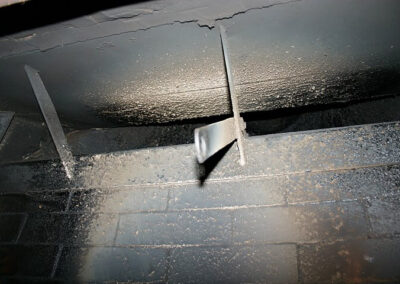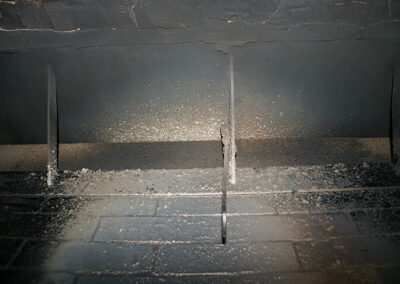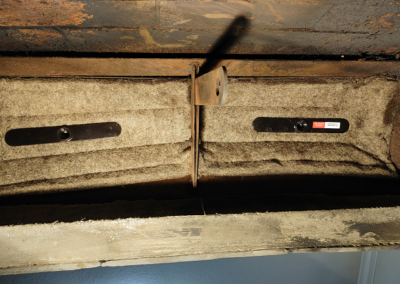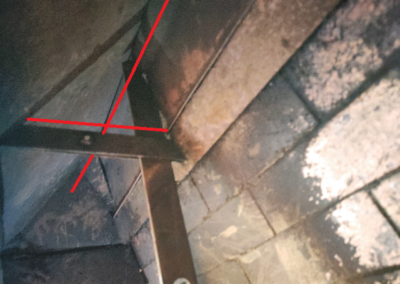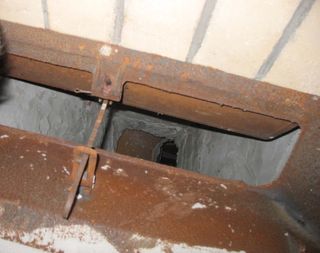
by blogediter | Jul 18, 2018 | Chimney Plugs
Q: Jason, I am trying to decide whether to put a Chimney Balloon in above or below my flue damper. You can see in the picture here what the damper looks like. The area below the damper is a trapezoid of 29″ x 20″ x 34″. Should I put a Chimney Balloon in this space?
The area above the flue damper is 30″x12″. You can see that in the second picture. – JR
A: Dear JR, By looking at this vestal damper application I would say the best location to put a Chimney Balloon in is above the damper door. The area below the damper has quite a bit of hardware in the way since the handle, the handle retaining clip, and the glass door retaining screws are all down there.
It also looks like your chimney flue was also recently re-mortared, although I am not sure it was done by a pro. The texture is quite rough and the surface is uneven. But this nice clean surface will make it easier to install the Chimney Balloon in that area.
You can put the Chimney Balloon in just above where the damper door is when it is open. When you inflate it in place the bottom of the Chimney Balloon will actually rest on the damper doors front edge.
Another option is to remove the damper door so you only have the frame of the damper in the fireplace and then install the Chimney Balloon just above the frame.
To remove the damper door just pull the cotter pin from the damper handle assembly ( you can see the cotter pin in your first picture) and remove the damper handle. Once that is removed you can reach up and lift the damper door off of the lip of the damper frame. There is no hinge on these dampers, they are just held in place by gravity.
Once the handle and door are out of the way you can simply install the Chimney Balloon above the damper frame. – Jason
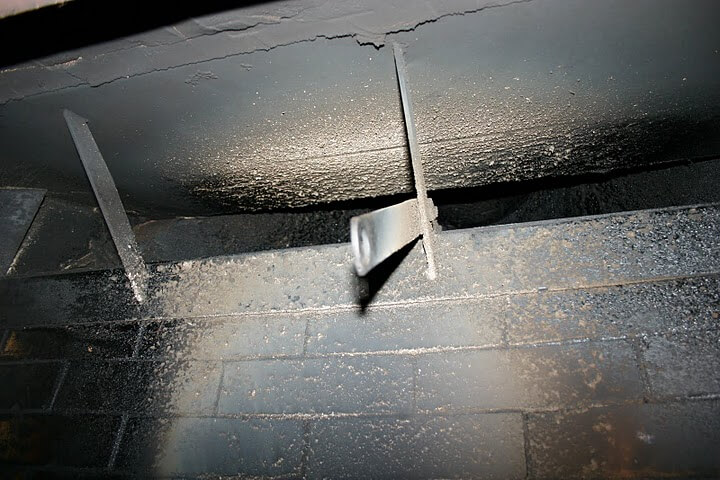
by blogediter | Aug 25, 2017 | Fireplaces
#23: I have a Swing Handle Damper with Bar Supports, How Do I Plug the Flue?
23-1 Swing handle damper open
23-2 Swing handle damper closed
23-3 Swing handle damper with Flueblocker behind the horizontal bracket
23-4 Measure length and width above the horizontal bracket
Fireplace #23: Swing Handle Damper with Supports and High Flue Tile
These Swing Handle Dampers are very common in masonry fireplaces of solid brick or stone. These are their characteristics:
- They have a long rectangular sheet iron damper frame and matching door.
- The door has a straight cast iron handle sticking down attached to a horizontal support. (image 23-2)
- The handle swings forward and back.
- All of the hardware is welded or bolted and is not removable.
- The damper door is almost straight vertical when closed.
- There are sometimes welded metal horizontal bracers below the damper (image 23-2)
This damper style is best sealed with a long rectangle Flueblocker (image 23-3). You will measure the length and depth of the area right above the horizontal bracket (image 23-4). The Flueblocker will lay right on top of those horizontal brackets. You will need to cut a small slit in the Flueblocker wool pad to accommodate the straight metal damper handle to stick through (image 23-3). Since you are threading the wool pad through a tight triangular area, it is easiest to thread the wool pad into place above the horizontal supports without the black plastic Flueblocker handles attached (image 23-3).
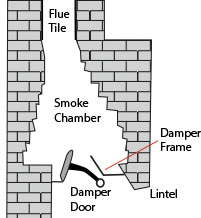
by blogediter | Aug 23, 2017 | Fireplaces
So you want to know the names of the parts of a fireplace and chimney?
Just so we have our chimney terminology straight, here is a labeled diagram of the parts of a fireplace and chimney.
This is a list of the names of the parts of a fireplace and chimney:
Ash Chute: A hole in the floor of the firebox that you can sweep ash and burnt debris into. It is often connected to a pocket area below the firebox of in the basement that has an small metal exterior door for removal of fireplace ash.
Crown: The crown of the chimney is the flat surface at the top of the chimney structure. This is also the platform on which the chimney cap sits.
Damper Door: This is a metal door that pivots and open and closes. Sometimes it has a hinge and sometimes it is just a metal flap setting in place by gravity. They can be cast iron or sheet metal. Homeowners often call the damper the “flue” or “flume” but in fact the flue is the hole that the damper is closing off.
Damper Frame: This is the metal frame that is mortared in place and is immovable. The damper door connects against this frame. The frame can be sheet metal or cast iron.
Firebox: This is the open mouth area of the hearth that you put the logs and have the fire.
Flue Tile: This is the area of the chimney where the walls are parallel and the chimney makes a long run to the chimney top. It is often lined with a clay flue tile, or a metal flue liner. Sometimes it is just bare brick.
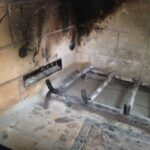
fresh air intake part of a fireplace
Fresh Air Inlet: This is not shown on our diagram, but the left image is a photo of one. This is a vent on the side or back wall of the firebox that vents through the wall to the outside. Fresh air intakes are designed to give the firebox plenty of outside combustion air while you have a fire burning.
Lintel: This is the top lip of the fireplace hearth opening. If you are setting a log in the firebox and you hit your head on the bricks above your head… that is the lintel.


